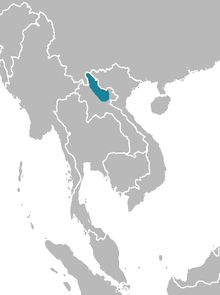| Roosevelt's muntjac | |
|---|---|
| Scientific classification | |
| Domain: | Eukaryota |
| Kingdom: | Animalia |
| Phylum: | Chordata |
| Class: | Mammalia |
| Order: | Artiodactyla |
| Family: | Cervidae |
| Subfamily: | Cervinae |
| Genus: | Muntiacus |
| Species: | M. rooseveltorum
|
| Binomial name | |
| Muntiacus rooseveltorum Osgood, 1932
| |

| |
A single specimen of the Roosevelt's muntjac or Roosevelt's barking deer (Muntiacus rooseveltorum) was presented to the Field Museum in 1929 following the Kelley-Roosevelts expedition organized by Theodore (Jnr) and Kermit Roosevelt. The specimen is slightly smaller than the common muntjac and DNA testing has shown it to be distinct from recently discovered muntjac species. It is a subspecies of Fea's muntjac, whose home range is mountains further northwest separated by lower land. However, without further evidence, the exact position of Roosevelt's muntjac cannot be stated. Berlin Zoo supposedly held this species between 1961 and 1972 (following an import from Northern Vietnam) but it could have been an Indian muntjac, subspecies annamensis.[2]
Roosevelt's muntjac was believed to have been extinct since 1929. However, there have been several recent claims to have rediscovered the species, from evidence including skulls owned by villagers in the Truong Son (Annamite) mountains of northern Laos and far northwestern Vietnam. More recently, photographs from a camera trap at Xuan Lien Nature Reserve in Vietnam appear to have identified two individuals.[3]
References[edit]
- ^ Timmins, R.; Duckworth, J.W. (2016). "Muntiacus rooseveltorum". IUCN Red List of Threatened Species. 2016: e.T13928A22160435. doi:10.2305/IUCN.UK.2016-1.RLTS.T13928A22160435.en. Retrieved 11 November 2021.
- ^ "Zootierliste's list of former and current holders of Roosevelts' muntjac in Europe".
- ^ "Deer supposedly extinct 85 years ago discovered in Vietnam". Thanh Nien News. March 6, 2014. Retrieved March 7, 2014.
- Rediscovery of Roosevelt's Barking Deer (Muntiacus rooseveltorum), George Amato, Mary G. Egan, George B. Schaller, Richard H. Baker, Howard C. Rosenbaum, William G. Robichaud, Rob DeSalle, Journal of Mammalogy, Vol. 80, No. 2 (May, 1999), pp. 639–643 [1]

Well, that’s interesting to know that Psilotum nudum are known as whisk ferns. Psilotum nudum is the commoner species of the two. While the P. flaccidum is a rare species and is found in the tropical islands. Both the species are usually epiphytic in habit and grow upon tree ferns. These species may also be terrestrial and grow in humus or in the crevices of the rocks.
View the detailed Guide of Psilotum nudum: Detailed Study Of Psilotum Nudum (Whisk Fern), Classification, Anatomy, Reproduction